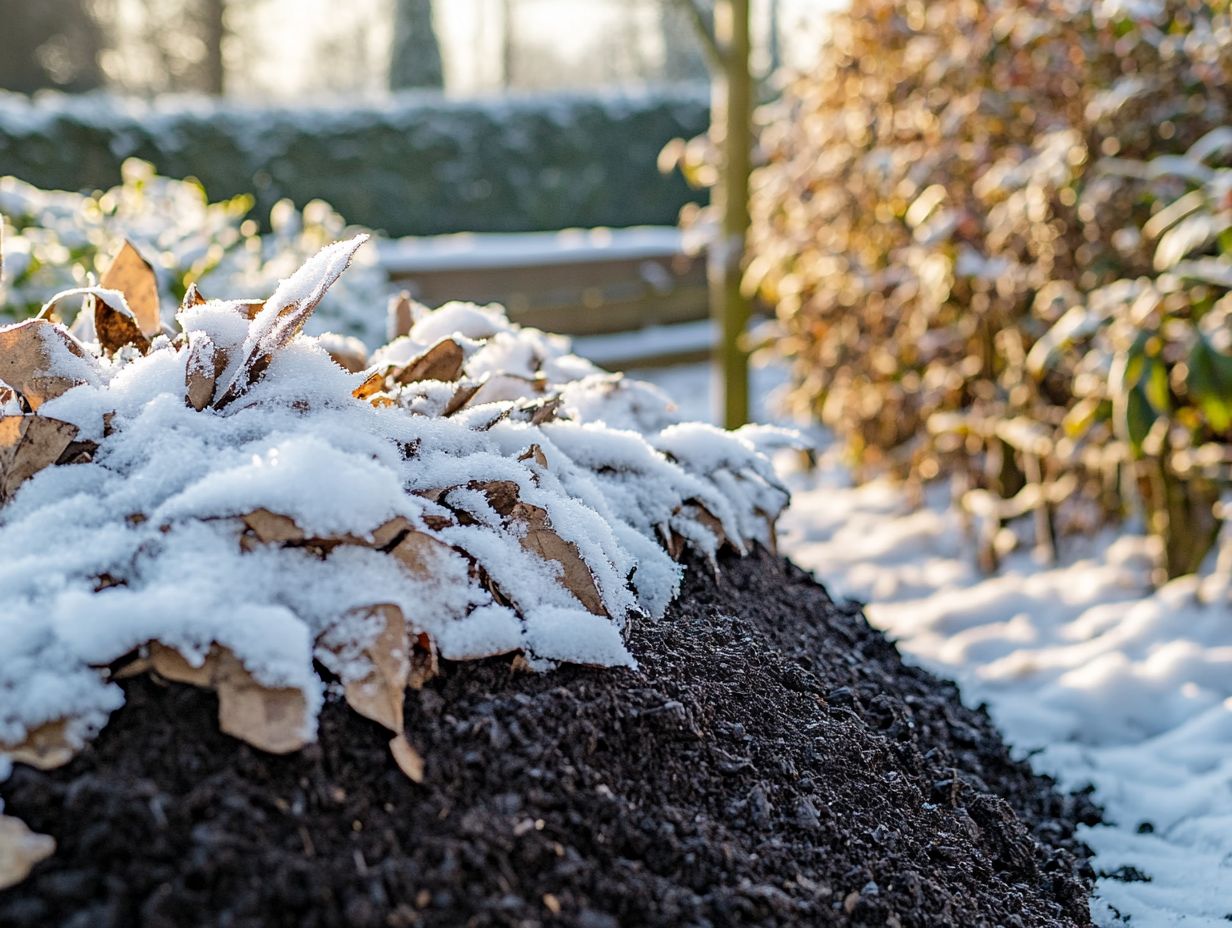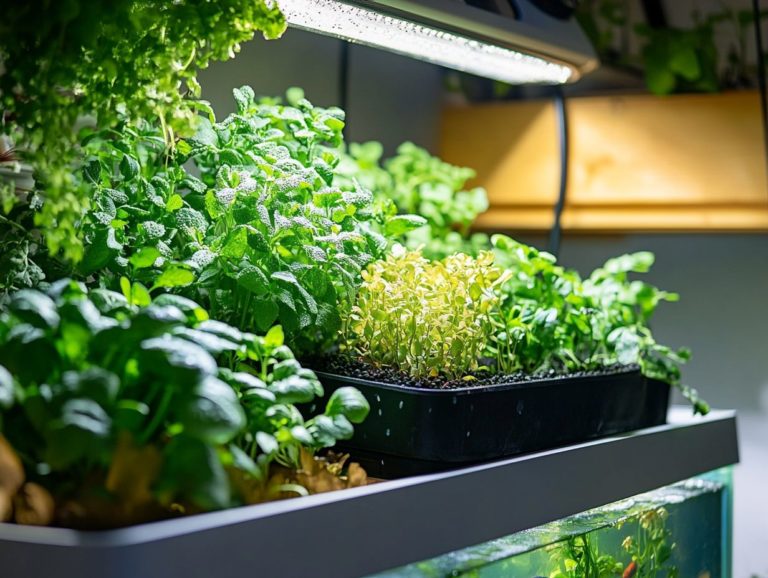Using Compost as Winter Insulation
As winter approaches, you re likely on the hunt for effective and sustainable ways to insulate your home. One solution that often flies under the radar is compost, which offers a unique and eco-friendly approach.
This article will shine a light on the benefits of using compost as winter insulation, showcasing its advantages over traditional materials. You ll learn how to prepare and apply compost effectively to maximize its insulating properties.
You’ll also discover the long-term environmental and financial benefits, as well as alternative winter uses for compost. Embrace sustainability this winter and transform your approach to insulation!
Contents
- Key Takeaways:
- The Benefits of Using Compost as Winter Insulation
- How to Prepare Compost for Insulation
- Application Techniques for Compost Insulation
- Maximizing the Insulating Effect of Compost
- Long-Term Benefits of Using Compost as Insulation
- Alternative Uses for Compost in Winter
- Frequently Asked Questions
- Can I use compost as insulation during the winter?
- How do I use compost as winter insulation?
- What are the benefits of using compost as winter insulation?
- Is it better to use compost or mulch for winter insulation?
- What type of compost is best for winter insulation?
- How often should I replace the compost insulation?
Key Takeaways:

- Compost is a natural and sustainable option for winter insulation, providing a range of benefits over other materials.
- Creating insulating compost is a simple process that involves layering organic materials and allowing them to decompose.
- To maximize the insulating effect of compost, it is important to apply it correctly and consider the specific winter conditions in your area.
The Benefits of Using Compost as Winter Insulation
Using compost as winter insulation comes with a wealth of benefits, making it a sustainable choice for those aiming to retain warmth and cut down on energy costs during the colder months. Additionally, using mulch to protect winter crops can enhance your gardening efforts. Rich in organic matter, compost serves as an excellent insulator, reducing heat loss while allowing you to recycle kitchen scraps and other organic materials into a valuable resource.
This approach not only champions eco-friendliness but also enriches your compost pile with essential nutrients that can be utilized in gardening when spring rolls around. It’s an efficient cycle that supports both effective insulation and thriving soil health.
Why Choose Compost Over Other Materials?
Compost truly shines as an insulation material, thanks to its sustainable properties. It improves thermal insulation while making a positive impact on the environment by repurposing organic matter that would otherwise go to waste.
This innovative approach boasts impressive thermal performance, often surpassing traditional materials like polystyrene or fiberglass. By opting for compost, you can reduce your energy costs through enhanced insulation while helping to keep waste out of landfills.
Incorporating wood ash into your compost can amplify its insulating effectiveness; the mineral content adds density and thermal mass. If you re looking for eco-friendly building solutions, compost is an attractive and responsible choice that champions sustainability while boosting energy efficiency.
How to Prepare Compost for Insulation
Preparing compost for insulation requires a thoughtful approach that results in an active pile brimming with nutrients, capable of serving as an effective layer that keeps out the cold.
By blending brown materials such as straw bales and wood ash with green materials like kitchen scraps and coffee grounds, and ensuring proper aeration to minimize odors, you can significantly enhance the decomposition process within your compost bin.
Furthermore, adding earthworms boosts nutrient availability and creates a highly efficient insulation layer, optimizing your compost’s performance.
Steps for Creating Insulating Compost
To create insulating compost, begin by gathering your kitchen scraps and other organic materials. Aim for a balanced mix of nitrogen-rich greens and carbon-rich browns to facilitate effective decomposition.
Next, collect items like vegetable peels, coffee grounds, dried leaves, and shredded paper. It s essential to chop larger pieces into smaller bits to encourage a quicker breakdown.
Layer these components in your compost bin or pile, alternating between green and brown materials. Proper aeration is crucial, so make it a habit to turn the compost regularly with a pitchfork or shovel. This allows oxygen to circulate, promoting vital microbial activity.
Monitor moisture levels by checking your compost periodically. It should feel damp but not soggy. If it s too dry, simply add some water or more greens. If it s too wet, mix in more browns to achieve the perfect balance for successful insulation.
Don’t miss out on this amazing way to insulate your home sustainably! Start your composting journey today for a cozier, more sustainable winter!
Application Techniques for Compost Insulation

Mastering effective application techniques for compost insulation is essential for unlocking its full potential as a sustainable solution to tackle winter challenges. By doing so, you can maintain optimal heat insulation around your structures, gardens, and landscaping, ensuring they thrive despite the chill.
Best Practices for Applying Compost as Insulation
When applying compost as insulation, follow best practices like maintaining an optimal compost pile structure and ensuring adequate aeration. For those in colder regions, winter composting tips for cold climates can help you adapt to your local winter conditions and significantly enhance its effectiveness.
Keep your compost rich in nitrogen, carbon, and moisture for the best insulating material. Regularly turning the compost pile encourages air circulation, crucial for microbial activity and helps maintain heat.
It’s also essential to monitor specific winter conditions. Factors like temperature fluctuations and moisture levels may require you to adjust the application thickness or layering. Using natural materials as a cover can keep the compost warmer while adding valuable nutrients.
By emphasizing these components, you improve heat retention and promote sustainable gardening practices.
Maximizing the Insulating Effect of Compost
Maximize compost’s insulating effect by considering key factors. These include using an external heating source, maintaining high organic matter levels, and fostering heat-loving microbes that excel in a warm compost environment.
Each element plays a vital role in creating an optimal insulating effect, ensuring your compost performs at its best.
Tips for Using Compost in Different Winter Conditions
When using compost in varying winter conditions, adapt your approach to maintain insulation heat and ensure your gardening efforts remain effective, no matter the climatic challenges.
To maximize the effectiveness of composting during the colder months, closely monitor temperature fluctuations and adjust your compost pile as needed. Incorporating materials that retain heat, such as straw or old blankets, can provide essential insulation.
It s crucial to keep a watchful eye on moisture levels, as snow or rain can lead to excess water, turning your compost anaerobic.
If you re looking to enhance your compost bin design, consider tapping into local resources like a metal recycler. Metal bins offer durability and can help regulate temperatures when properly insulated.
By integrating these seasonal strategies, you can ensure that your composting efforts yield rich, nutritious soil come spring.
Long-Term Benefits of Using Compost as Insulation
Using compost as insulation offers fantastic long-term benefits. You ll not only enjoy lower heating costs but also contribute positively to our environment.
Environmental and Financial Impacts

The environmental and financial impacts of compost insulation are truly remarkable. You achieve significant energy savings while making a positive contribution to ecological sustainability through waste reduction and resource recycling.
By using organic materials that might otherwise end up in landfills, compost insulation not only helps you divert waste from these sites but also promotes a circular economy.
This innovative approach can considerably reduce your heating and cooling costs, making living and operating expenses much more manageable.
As an energy-efficient insulation option, it helps maintain consistent indoor temperatures, further decreasing your reliance on fossil fuels. Embracing compost as insulation showcases your commitment to sustainable practices, potentially inspiring your community to adopt greener building methods while enjoying the financial benefits.
Act now! By embracing compost insulation, you’re not just saving money; you’re also making a real difference for our planet!
Alternative Uses for Compost in Winter
Compost offers a range of alternative uses during winter that go beyond mere insulation. It plays a vital role in supporting winter sustainability efforts across various gardening applications, helping plants avoid frost stop and thrive even in colder months.
Other Ways to Use Compost for Winter Sustainability
You can enhance winter sustainability in your garden by using compost as a protective mulch. This not only retains soil health and moisture but also ensures your plants remain robust and well-supported throughout the harsh winter months.
Incorporating compost into your garden bed before the first frost can improve soil structure. This creates a rich, nutrient-dense environment that nourishes plant roots during the cold season. This organic matter protects the soil from erosion and promotes the activity of beneficial organisms in the soil, which are essential for breaking down nutrients for your plants.
Compost also acts as insulation for delicate perennials, shielding them from severe temperature fluctuations. Try these methods to create a thriving garden, even in the cold!
Frequently Asked Questions
Can I use compost as insulation during the winter?
Yes, compost can be an effective winter insulation material. Its high nutrient and moisture content make it a great insulator for plants and soil.
How do I use compost as winter insulation?

Simply spread a layer of compost around the base of your plants, covering the soil and root system. You can also mix compost with straw or leaves to create a thicker layer of insulation.
What are the benefits of using compost as winter insulation?
Aside from providing insulation, compost adds nutrients to the soil and helps retain moisture, promoting healthier plant growth. It also improves soil structure and drainage.
Is it better to use compost or mulch for winter insulation?
Both compost and mulch can be effective winter insulation materials. However, compost has the added benefit of providing nutrients to the soil, while mulch primarily acts as a barrier against temperature changes.
What type of compost is best for winter insulation?
It is best to use mature, well-rotted compost for winter insulation. This means compost that has fully decomposed and is dark brown. Fresh compost may still be breaking down and could harm plants, while too much moisture in immature compost can lead to mold growth.
How often should I replace the compost insulation?
The compost insulation should be replaced every winter season. As it breaks down over time, it becomes less effective as an insulator and may also need to be replenished with fresh nutrients for the plants.
Start using compost this winter to protect your plants and enhance your garden!






